Swinburne University: ACC30005 Taxation Law Letter of Advice
VerifiedAdded on 2023/01/03
|11
|2593
|89
Report
AI Summary
This report is a taxation law letter of advice prepared for a business partnership, addressing key taxation issues. It analyzes the partners' income, including cash receipts and bonus amounts, determining whether they constitute ordinary income subject to taxation. The report examines various expenses, such as legal costs, bad debts, depreciation of assets, car running expenses, and travel expenses, to determine their deductibility under relevant tax legislation. It also considers the tax implications of partner salaries and the calculation of the partnership's net income, providing a detailed computation of the assessable income, allowable deductions, and the final distribution of income to each partner. The report references relevant case law and legislation to support its conclusions.
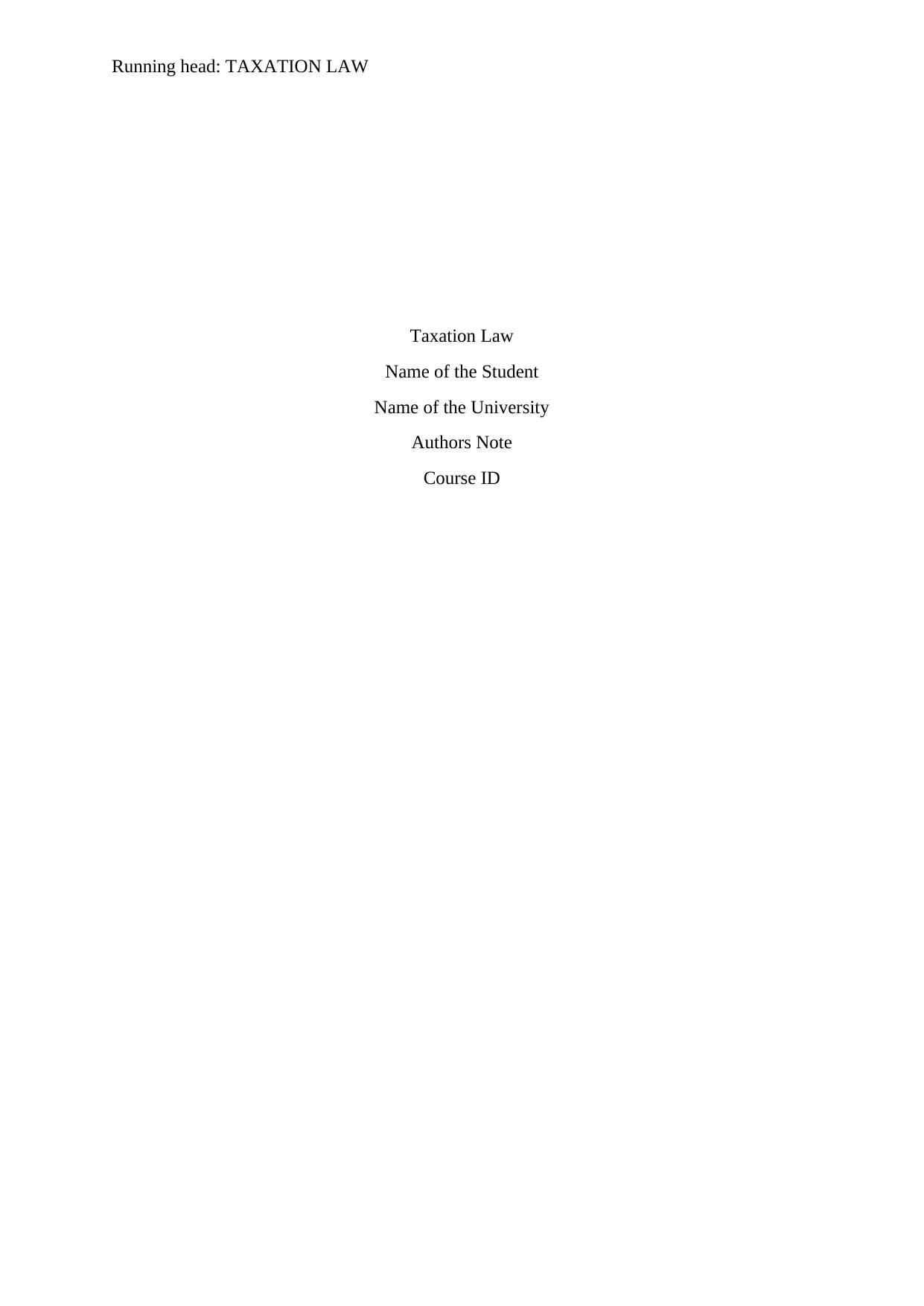
Running head: TAXATION LAW
Taxation Law
Name of the Student
Name of the University
Authors Note
Course ID
Taxation Law
Name of the Student
Name of the University
Authors Note
Course ID
Paraphrase This Document
Need a fresh take? Get an instant paraphrase of this document with our AI Paraphraser
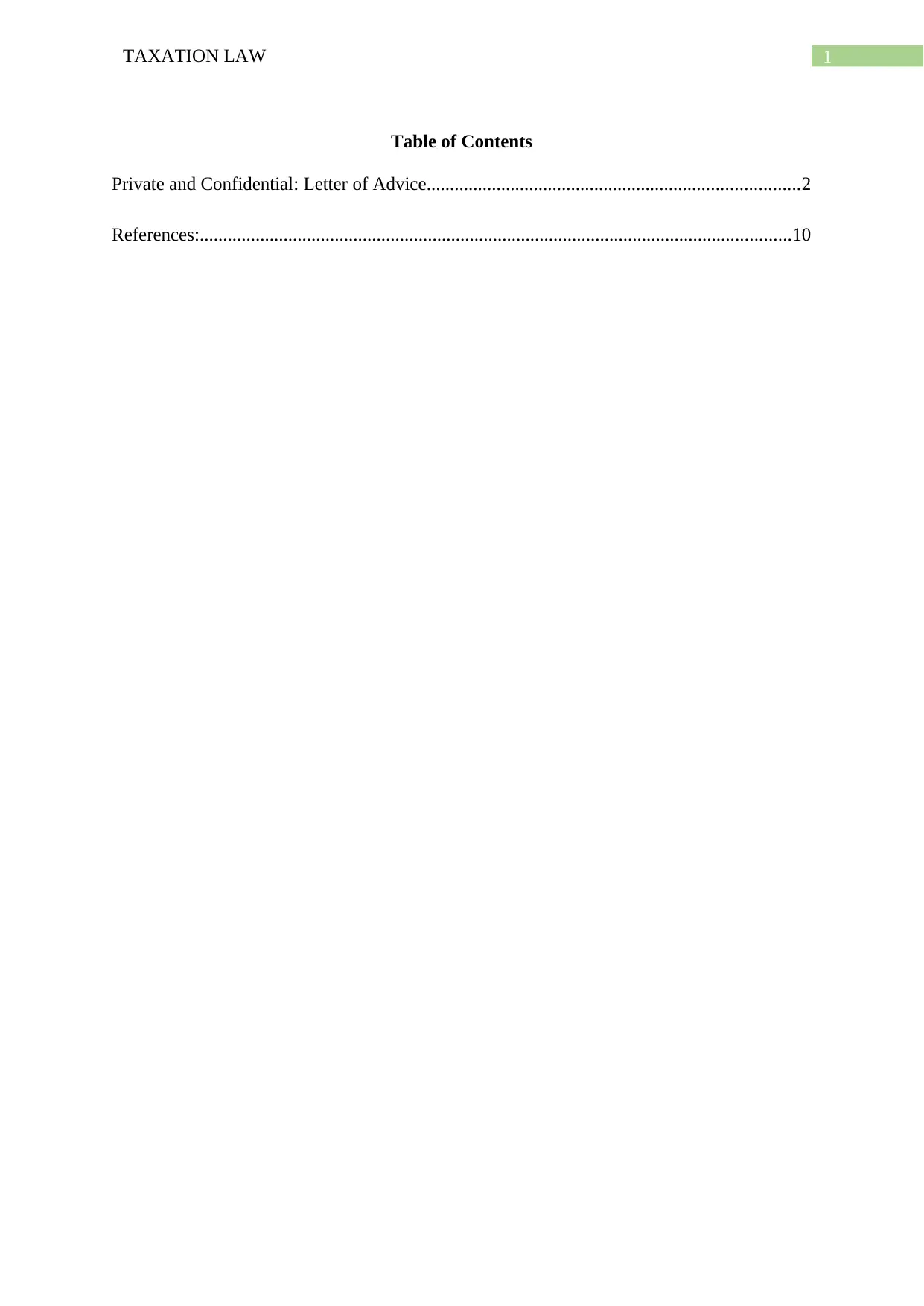
1TAXATION LAW
Table of Contents
Private and Confidential: Letter of Advice................................................................................2
References:...............................................................................................................................10
Table of Contents
Private and Confidential: Letter of Advice................................................................................2
References:...............................................................................................................................10
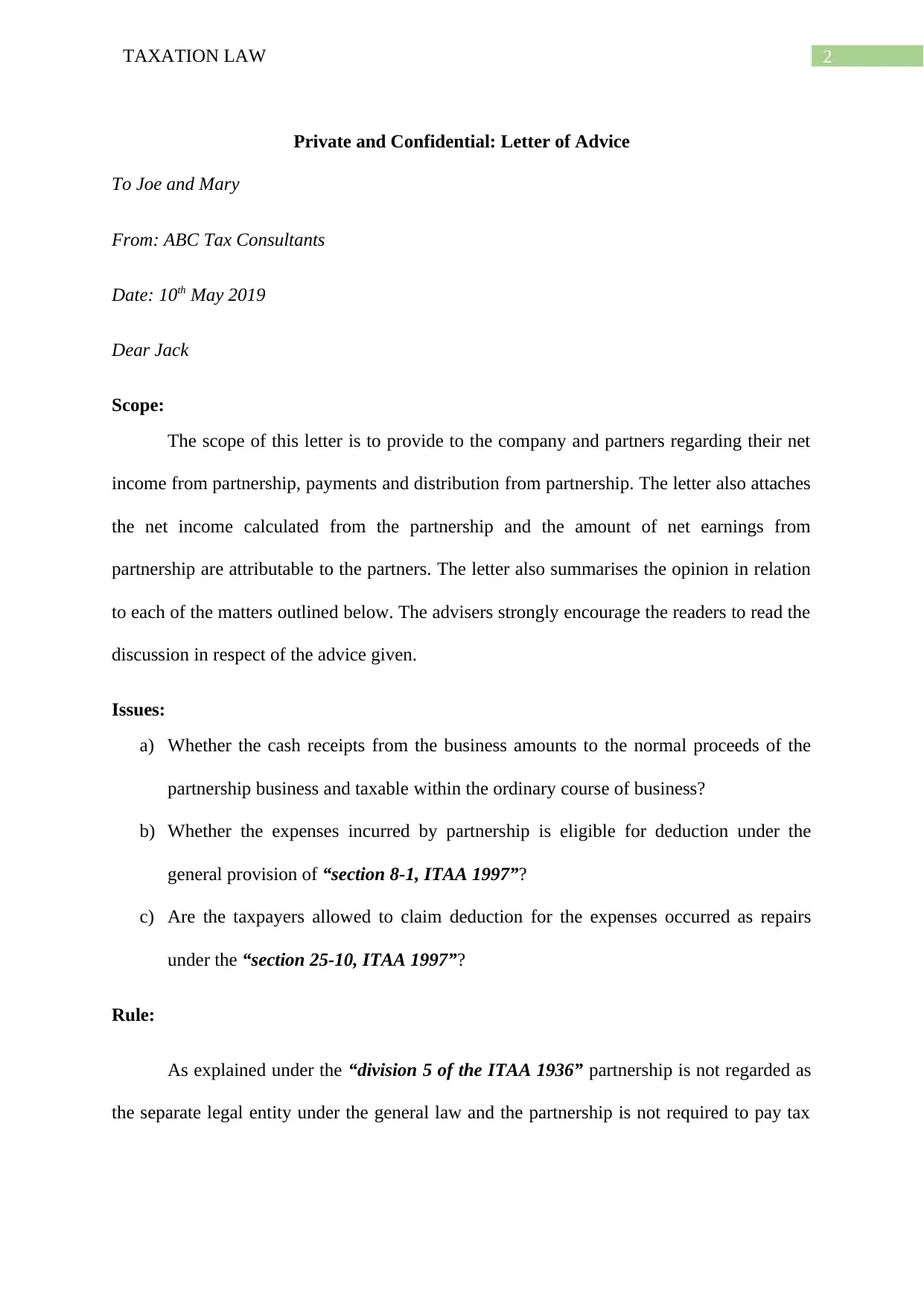
2TAXATION LAW
Private and Confidential: Letter of Advice
To Joe and Mary
From: ABC Tax Consultants
Date: 10th May 2019
Dear Jack
Scope:
The scope of this letter is to provide to the company and partners regarding their net
income from partnership, payments and distribution from partnership. The letter also attaches
the net income calculated from the partnership and the amount of net earnings from
partnership are attributable to the partners. The letter also summarises the opinion in relation
to each of the matters outlined below. The advisers strongly encourage the readers to read the
discussion in respect of the advice given.
Issues:
a) Whether the cash receipts from the business amounts to the normal proceeds of the
partnership business and taxable within the ordinary course of business?
b) Whether the expenses incurred by partnership is eligible for deduction under the
general provision of “section 8-1, ITAA 1997”?
c) Are the taxpayers allowed to claim deduction for the expenses occurred as repairs
under the “section 25-10, ITAA 1997”?
Rule:
As explained under the “division 5 of the ITAA 1936” partnership is not regarded as
the separate legal entity under the general law and the partnership is not required to pay tax
Private and Confidential: Letter of Advice
To Joe and Mary
From: ABC Tax Consultants
Date: 10th May 2019
Dear Jack
Scope:
The scope of this letter is to provide to the company and partners regarding their net
income from partnership, payments and distribution from partnership. The letter also attaches
the net income calculated from the partnership and the amount of net earnings from
partnership are attributable to the partners. The letter also summarises the opinion in relation
to each of the matters outlined below. The advisers strongly encourage the readers to read the
discussion in respect of the advice given.
Issues:
a) Whether the cash receipts from the business amounts to the normal proceeds of the
partnership business and taxable within the ordinary course of business?
b) Whether the expenses incurred by partnership is eligible for deduction under the
general provision of “section 8-1, ITAA 1997”?
c) Are the taxpayers allowed to claim deduction for the expenses occurred as repairs
under the “section 25-10, ITAA 1997”?
Rule:
As explained under the “division 5 of the ITAA 1936” partnership is not regarded as
the separate legal entity under the general law and the partnership is not required to pay tax
⊘ This is a preview!⊘
Do you want full access?
Subscribe today to unlock all pages.

Trusted by 1+ million students worldwide
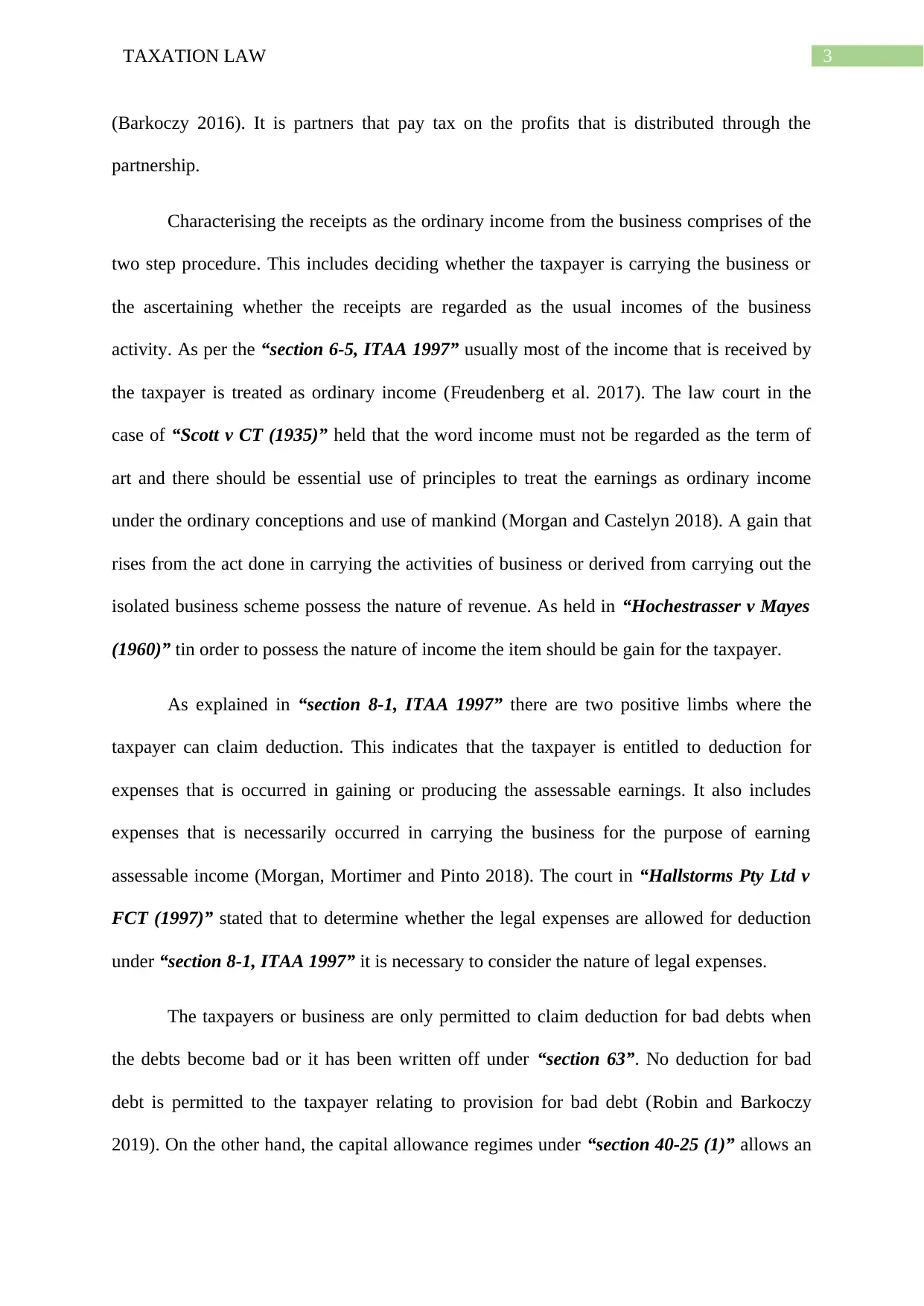
3TAXATION LAW
(Barkoczy 2016). It is partners that pay tax on the profits that is distributed through the
partnership.
Characterising the receipts as the ordinary income from the business comprises of the
two step procedure. This includes deciding whether the taxpayer is carrying the business or
the ascertaining whether the receipts are regarded as the usual incomes of the business
activity. As per the “section 6-5, ITAA 1997” usually most of the income that is received by
the taxpayer is treated as ordinary income (Freudenberg et al. 2017). The law court in the
case of “Scott v CT (1935)” held that the word income must not be regarded as the term of
art and there should be essential use of principles to treat the earnings as ordinary income
under the ordinary conceptions and use of mankind (Morgan and Castelyn 2018). A gain that
rises from the act done in carrying the activities of business or derived from carrying out the
isolated business scheme possess the nature of revenue. As held in “Hochestrasser v Mayes
(1960)” tin order to possess the nature of income the item should be gain for the taxpayer.
As explained in “section 8-1, ITAA 1997” there are two positive limbs where the
taxpayer can claim deduction. This indicates that the taxpayer is entitled to deduction for
expenses that is occurred in gaining or producing the assessable earnings. It also includes
expenses that is necessarily occurred in carrying the business for the purpose of earning
assessable income (Morgan, Mortimer and Pinto 2018). The court in “Hallstorms Pty Ltd v
FCT (1997)” stated that to determine whether the legal expenses are allowed for deduction
under “section 8-1, ITAA 1997” it is necessary to consider the nature of legal expenses.
The taxpayers or business are only permitted to claim deduction for bad debts when
the debts become bad or it has been written off under “section 63”. No deduction for bad
debt is permitted to the taxpayer relating to provision for bad debt (Robin and Barkoczy
2019). On the other hand, the capital allowance regimes under “section 40-25 (1)” allows an
(Barkoczy 2016). It is partners that pay tax on the profits that is distributed through the
partnership.
Characterising the receipts as the ordinary income from the business comprises of the
two step procedure. This includes deciding whether the taxpayer is carrying the business or
the ascertaining whether the receipts are regarded as the usual incomes of the business
activity. As per the “section 6-5, ITAA 1997” usually most of the income that is received by
the taxpayer is treated as ordinary income (Freudenberg et al. 2017). The law court in the
case of “Scott v CT (1935)” held that the word income must not be regarded as the term of
art and there should be essential use of principles to treat the earnings as ordinary income
under the ordinary conceptions and use of mankind (Morgan and Castelyn 2018). A gain that
rises from the act done in carrying the activities of business or derived from carrying out the
isolated business scheme possess the nature of revenue. As held in “Hochestrasser v Mayes
(1960)” tin order to possess the nature of income the item should be gain for the taxpayer.
As explained in “section 8-1, ITAA 1997” there are two positive limbs where the
taxpayer can claim deduction. This indicates that the taxpayer is entitled to deduction for
expenses that is occurred in gaining or producing the assessable earnings. It also includes
expenses that is necessarily occurred in carrying the business for the purpose of earning
assessable income (Morgan, Mortimer and Pinto 2018). The court in “Hallstorms Pty Ltd v
FCT (1997)” stated that to determine whether the legal expenses are allowed for deduction
under “section 8-1, ITAA 1997” it is necessary to consider the nature of legal expenses.
The taxpayers or business are only permitted to claim deduction for bad debts when
the debts become bad or it has been written off under “section 63”. No deduction for bad
debt is permitted to the taxpayer relating to provision for bad debt (Robin and Barkoczy
2019). On the other hand, the capital allowance regimes under “section 40-25 (1)” allows an
Paraphrase This Document
Need a fresh take? Get an instant paraphrase of this document with our AI Paraphraser
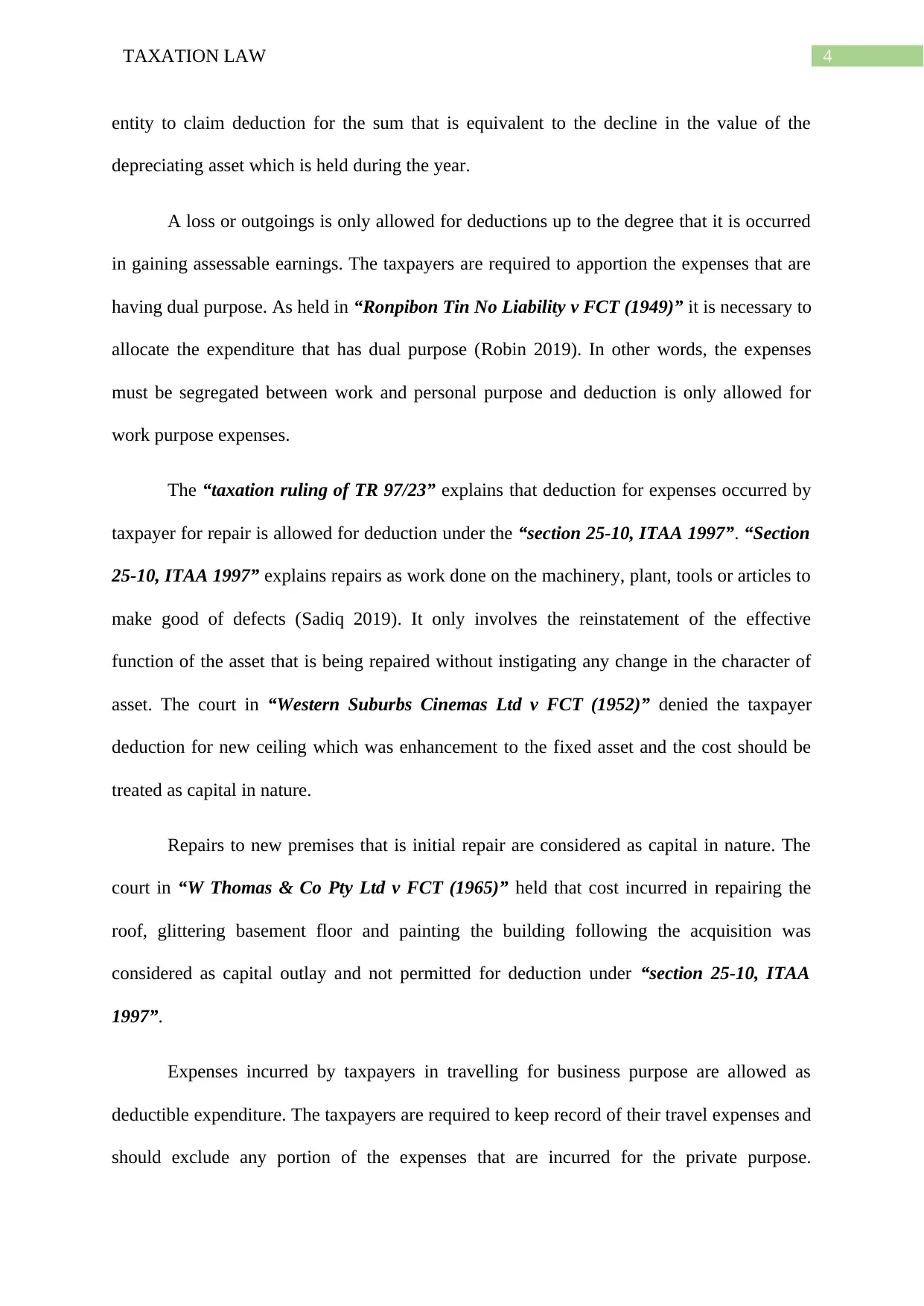
4TAXATION LAW
entity to claim deduction for the sum that is equivalent to the decline in the value of the
depreciating asset which is held during the year.
A loss or outgoings is only allowed for deductions up to the degree that it is occurred
in gaining assessable earnings. The taxpayers are required to apportion the expenses that are
having dual purpose. As held in “Ronpibon Tin No Liability v FCT (1949)” it is necessary to
allocate the expenditure that has dual purpose (Robin 2019). In other words, the expenses
must be segregated between work and personal purpose and deduction is only allowed for
work purpose expenses.
The “taxation ruling of TR 97/23” explains that deduction for expenses occurred by
taxpayer for repair is allowed for deduction under the “section 25-10, ITAA 1997”. “Section
25-10, ITAA 1997” explains repairs as work done on the machinery, plant, tools or articles to
make good of defects (Sadiq 2019). It only involves the reinstatement of the effective
function of the asset that is being repaired without instigating any change in the character of
asset. The court in “Western Suburbs Cinemas Ltd v FCT (1952)” denied the taxpayer
deduction for new ceiling which was enhancement to the fixed asset and the cost should be
treated as capital in nature.
Repairs to new premises that is initial repair are considered as capital in nature. The
court in “W Thomas & Co Pty Ltd v FCT (1965)” held that cost incurred in repairing the
roof, glittering basement floor and painting the building following the acquisition was
considered as capital outlay and not permitted for deduction under “section 25-10, ITAA
1997”.
Expenses incurred by taxpayers in travelling for business purpose are allowed as
deductible expenditure. The taxpayers are required to keep record of their travel expenses and
should exclude any portion of the expenses that are incurred for the private purpose.
entity to claim deduction for the sum that is equivalent to the decline in the value of the
depreciating asset which is held during the year.
A loss or outgoings is only allowed for deductions up to the degree that it is occurred
in gaining assessable earnings. The taxpayers are required to apportion the expenses that are
having dual purpose. As held in “Ronpibon Tin No Liability v FCT (1949)” it is necessary to
allocate the expenditure that has dual purpose (Robin 2019). In other words, the expenses
must be segregated between work and personal purpose and deduction is only allowed for
work purpose expenses.
The “taxation ruling of TR 97/23” explains that deduction for expenses occurred by
taxpayer for repair is allowed for deduction under the “section 25-10, ITAA 1997”. “Section
25-10, ITAA 1997” explains repairs as work done on the machinery, plant, tools or articles to
make good of defects (Sadiq 2019). It only involves the reinstatement of the effective
function of the asset that is being repaired without instigating any change in the character of
asset. The court in “Western Suburbs Cinemas Ltd v FCT (1952)” denied the taxpayer
deduction for new ceiling which was enhancement to the fixed asset and the cost should be
treated as capital in nature.
Repairs to new premises that is initial repair are considered as capital in nature. The
court in “W Thomas & Co Pty Ltd v FCT (1965)” held that cost incurred in repairing the
roof, glittering basement floor and painting the building following the acquisition was
considered as capital outlay and not permitted for deduction under “section 25-10, ITAA
1997”.
Expenses incurred by taxpayers in travelling for business purpose are allowed as
deductible expenditure. The taxpayers are required to keep record of their travel expenses and
should exclude any portion of the expenses that are incurred for the private purpose.
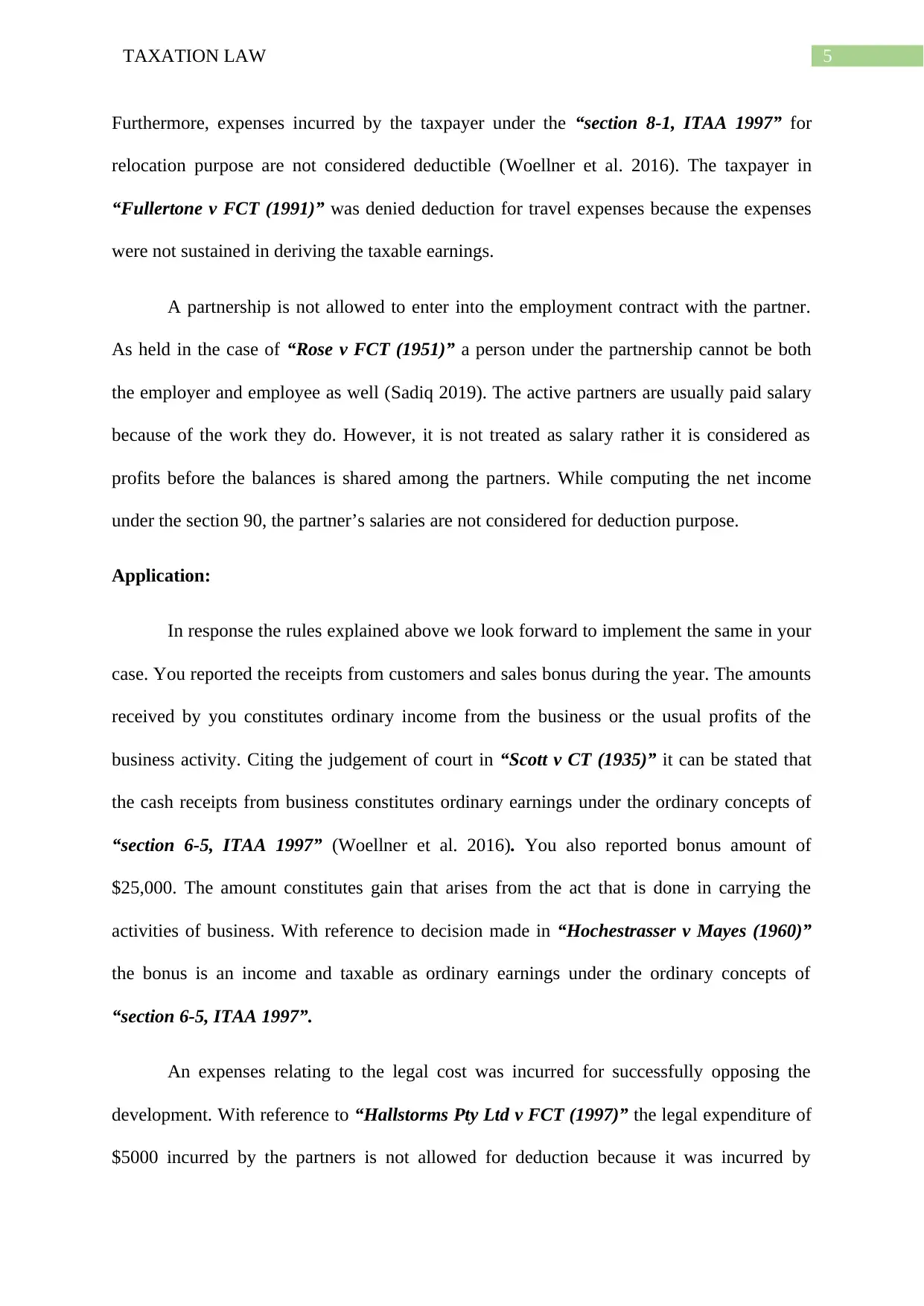
5TAXATION LAW
Furthermore, expenses incurred by the taxpayer under the “section 8-1, ITAA 1997” for
relocation purpose are not considered deductible (Woellner et al. 2016). The taxpayer in
“Fullertone v FCT (1991)” was denied deduction for travel expenses because the expenses
were not sustained in deriving the taxable earnings.
A partnership is not allowed to enter into the employment contract with the partner.
As held in the case of “Rose v FCT (1951)” a person under the partnership cannot be both
the employer and employee as well (Sadiq 2019). The active partners are usually paid salary
because of the work they do. However, it is not treated as salary rather it is considered as
profits before the balances is shared among the partners. While computing the net income
under the section 90, the partner’s salaries are not considered for deduction purpose.
Application:
In response the rules explained above we look forward to implement the same in your
case. You reported the receipts from customers and sales bonus during the year. The amounts
received by you constitutes ordinary income from the business or the usual profits of the
business activity. Citing the judgement of court in “Scott v CT (1935)” it can be stated that
the cash receipts from business constitutes ordinary earnings under the ordinary concepts of
“section 6-5, ITAA 1997” (Woellner et al. 2016). You also reported bonus amount of
$25,000. The amount constitutes gain that arises from the act that is done in carrying the
activities of business. With reference to decision made in “Hochestrasser v Mayes (1960)”
the bonus is an income and taxable as ordinary earnings under the ordinary concepts of
“section 6-5, ITAA 1997”.
An expenses relating to the legal cost was incurred for successfully opposing the
development. With reference to “Hallstorms Pty Ltd v FCT (1997)” the legal expenditure of
$5000 incurred by the partners is not allowed for deduction because it was incurred by
Furthermore, expenses incurred by the taxpayer under the “section 8-1, ITAA 1997” for
relocation purpose are not considered deductible (Woellner et al. 2016). The taxpayer in
“Fullertone v FCT (1991)” was denied deduction for travel expenses because the expenses
were not sustained in deriving the taxable earnings.
A partnership is not allowed to enter into the employment contract with the partner.
As held in the case of “Rose v FCT (1951)” a person under the partnership cannot be both
the employer and employee as well (Sadiq 2019). The active partners are usually paid salary
because of the work they do. However, it is not treated as salary rather it is considered as
profits before the balances is shared among the partners. While computing the net income
under the section 90, the partner’s salaries are not considered for deduction purpose.
Application:
In response the rules explained above we look forward to implement the same in your
case. You reported the receipts from customers and sales bonus during the year. The amounts
received by you constitutes ordinary income from the business or the usual profits of the
business activity. Citing the judgement of court in “Scott v CT (1935)” it can be stated that
the cash receipts from business constitutes ordinary earnings under the ordinary concepts of
“section 6-5, ITAA 1997” (Woellner et al. 2016). You also reported bonus amount of
$25,000. The amount constitutes gain that arises from the act that is done in carrying the
activities of business. With reference to decision made in “Hochestrasser v Mayes (1960)”
the bonus is an income and taxable as ordinary earnings under the ordinary concepts of
“section 6-5, ITAA 1997”.
An expenses relating to the legal cost was incurred for successfully opposing the
development. With reference to “Hallstorms Pty Ltd v FCT (1997)” the legal expenditure of
$5000 incurred by the partners is not allowed for deduction because it was incurred by
⊘ This is a preview!⊘
Do you want full access?
Subscribe today to unlock all pages.

Trusted by 1+ million students worldwide
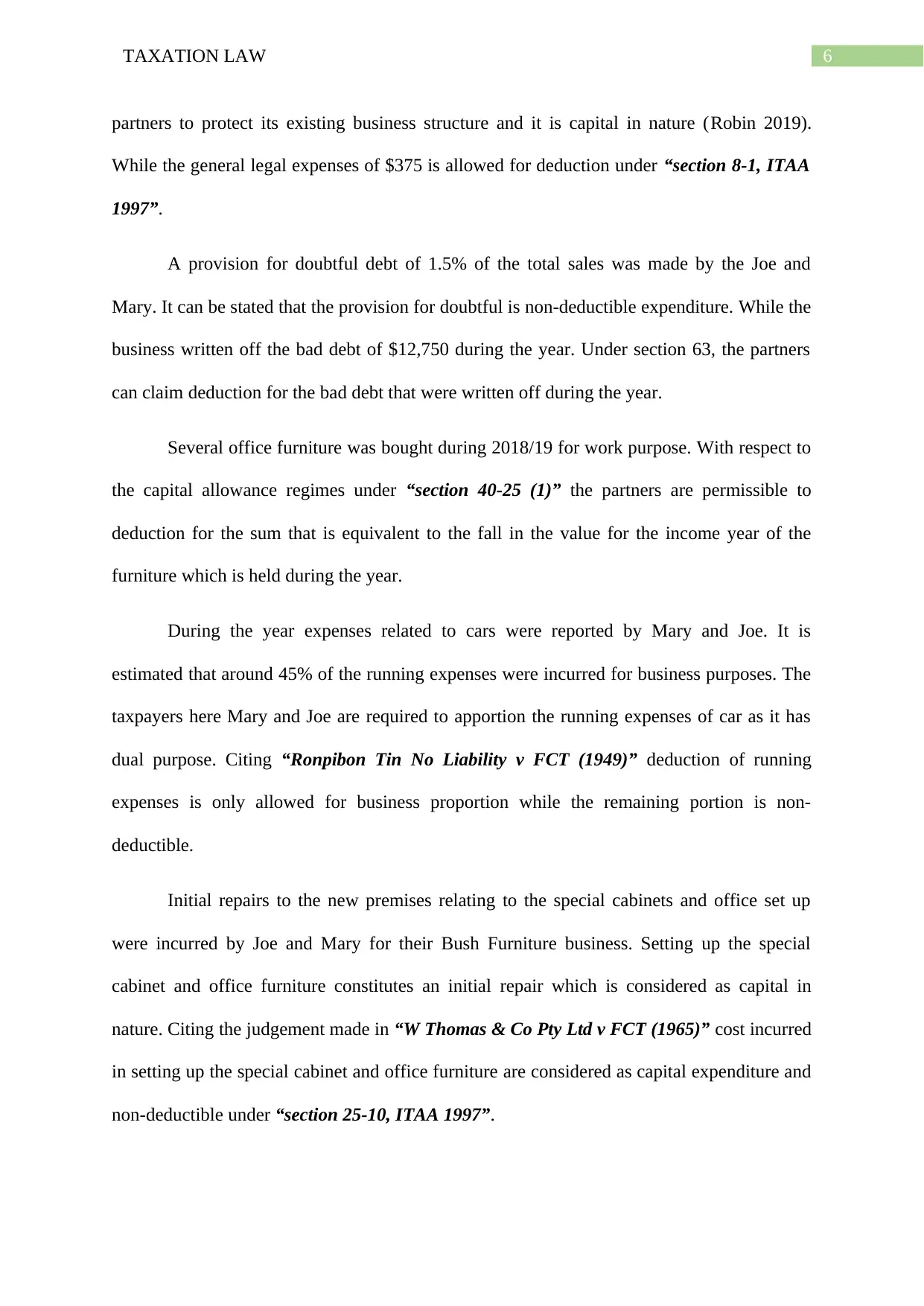
6TAXATION LAW
partners to protect its existing business structure and it is capital in nature (Robin 2019).
While the general legal expenses of $375 is allowed for deduction under “section 8-1, ITAA
1997”.
A provision for doubtful debt of 1.5% of the total sales was made by the Joe and
Mary. It can be stated that the provision for doubtful is non-deductible expenditure. While the
business written off the bad debt of $12,750 during the year. Under section 63, the partners
can claim deduction for the bad debt that were written off during the year.
Several office furniture was bought during 2018/19 for work purpose. With respect to
the capital allowance regimes under “section 40-25 (1)” the partners are permissible to
deduction for the sum that is equivalent to the fall in the value for the income year of the
furniture which is held during the year.
During the year expenses related to cars were reported by Mary and Joe. It is
estimated that around 45% of the running expenses were incurred for business purposes. The
taxpayers here Mary and Joe are required to apportion the running expenses of car as it has
dual purpose. Citing “Ronpibon Tin No Liability v FCT (1949)” deduction of running
expenses is only allowed for business proportion while the remaining portion is non-
deductible.
Initial repairs to the new premises relating to the special cabinets and office set up
were incurred by Joe and Mary for their Bush Furniture business. Setting up the special
cabinet and office furniture constitutes an initial repair which is considered as capital in
nature. Citing the judgement made in “W Thomas & Co Pty Ltd v FCT (1965)” cost incurred
in setting up the special cabinet and office furniture are considered as capital expenditure and
non-deductible under “section 25-10, ITAA 1997”.
partners to protect its existing business structure and it is capital in nature (Robin 2019).
While the general legal expenses of $375 is allowed for deduction under “section 8-1, ITAA
1997”.
A provision for doubtful debt of 1.5% of the total sales was made by the Joe and
Mary. It can be stated that the provision for doubtful is non-deductible expenditure. While the
business written off the bad debt of $12,750 during the year. Under section 63, the partners
can claim deduction for the bad debt that were written off during the year.
Several office furniture was bought during 2018/19 for work purpose. With respect to
the capital allowance regimes under “section 40-25 (1)” the partners are permissible to
deduction for the sum that is equivalent to the fall in the value for the income year of the
furniture which is held during the year.
During the year expenses related to cars were reported by Mary and Joe. It is
estimated that around 45% of the running expenses were incurred for business purposes. The
taxpayers here Mary and Joe are required to apportion the running expenses of car as it has
dual purpose. Citing “Ronpibon Tin No Liability v FCT (1949)” deduction of running
expenses is only allowed for business proportion while the remaining portion is non-
deductible.
Initial repairs to the new premises relating to the special cabinets and office set up
were incurred by Joe and Mary for their Bush Furniture business. Setting up the special
cabinet and office furniture constitutes an initial repair which is considered as capital in
nature. Citing the judgement made in “W Thomas & Co Pty Ltd v FCT (1965)” cost incurred
in setting up the special cabinet and office furniture are considered as capital expenditure and
non-deductible under “section 25-10, ITAA 1997”.
Paraphrase This Document
Need a fresh take? Get an instant paraphrase of this document with our AI Paraphraser
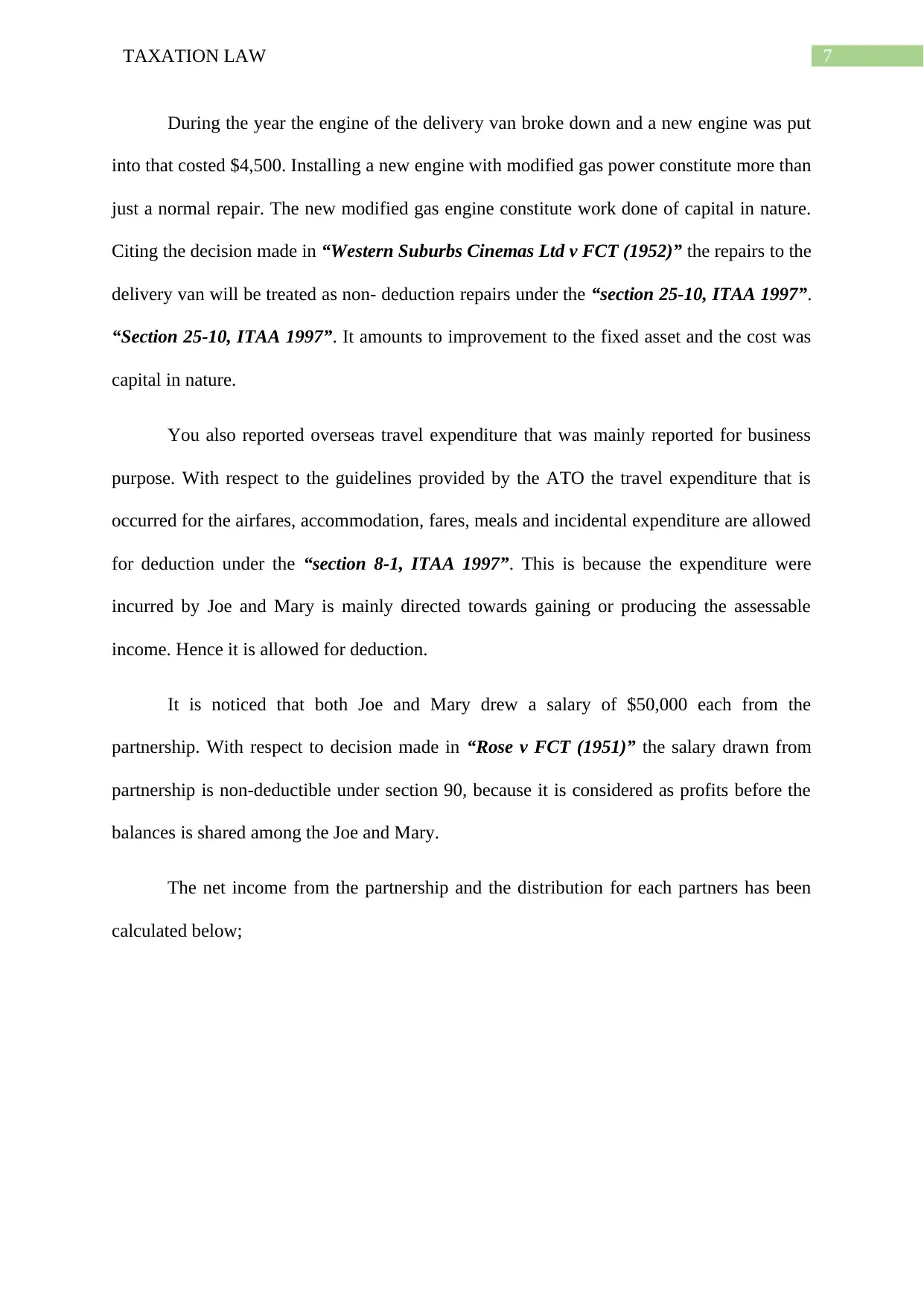
7TAXATION LAW
During the year the engine of the delivery van broke down and a new engine was put
into that costed $4,500. Installing a new engine with modified gas power constitute more than
just a normal repair. The new modified gas engine constitute work done of capital in nature.
Citing the decision made in “Western Suburbs Cinemas Ltd v FCT (1952)” the repairs to the
delivery van will be treated as non- deduction repairs under the “section 25-10, ITAA 1997”.
“Section 25-10, ITAA 1997”. It amounts to improvement to the fixed asset and the cost was
capital in nature.
You also reported overseas travel expenditure that was mainly reported for business
purpose. With respect to the guidelines provided by the ATO the travel expenditure that is
occurred for the airfares, accommodation, fares, meals and incidental expenditure are allowed
for deduction under the “section 8-1, ITAA 1997”. This is because the expenditure were
incurred by Joe and Mary is mainly directed towards gaining or producing the assessable
income. Hence it is allowed for deduction.
It is noticed that both Joe and Mary drew a salary of $50,000 each from the
partnership. With respect to decision made in “Rose v FCT (1951)” the salary drawn from
partnership is non-deductible under section 90, because it is considered as profits before the
balances is shared among the Joe and Mary.
The net income from the partnership and the distribution for each partners has been
calculated below;
During the year the engine of the delivery van broke down and a new engine was put
into that costed $4,500. Installing a new engine with modified gas power constitute more than
just a normal repair. The new modified gas engine constitute work done of capital in nature.
Citing the decision made in “Western Suburbs Cinemas Ltd v FCT (1952)” the repairs to the
delivery van will be treated as non- deduction repairs under the “section 25-10, ITAA 1997”.
“Section 25-10, ITAA 1997”. It amounts to improvement to the fixed asset and the cost was
capital in nature.
You also reported overseas travel expenditure that was mainly reported for business
purpose. With respect to the guidelines provided by the ATO the travel expenditure that is
occurred for the airfares, accommodation, fares, meals and incidental expenditure are allowed
for deduction under the “section 8-1, ITAA 1997”. This is because the expenditure were
incurred by Joe and Mary is mainly directed towards gaining or producing the assessable
income. Hence it is allowed for deduction.
It is noticed that both Joe and Mary drew a salary of $50,000 each from the
partnership. With respect to decision made in “Rose v FCT (1951)” the salary drawn from
partnership is non-deductible under section 90, because it is considered as profits before the
balances is shared among the Joe and Mary.
The net income from the partnership and the distribution for each partners has been
calculated below;
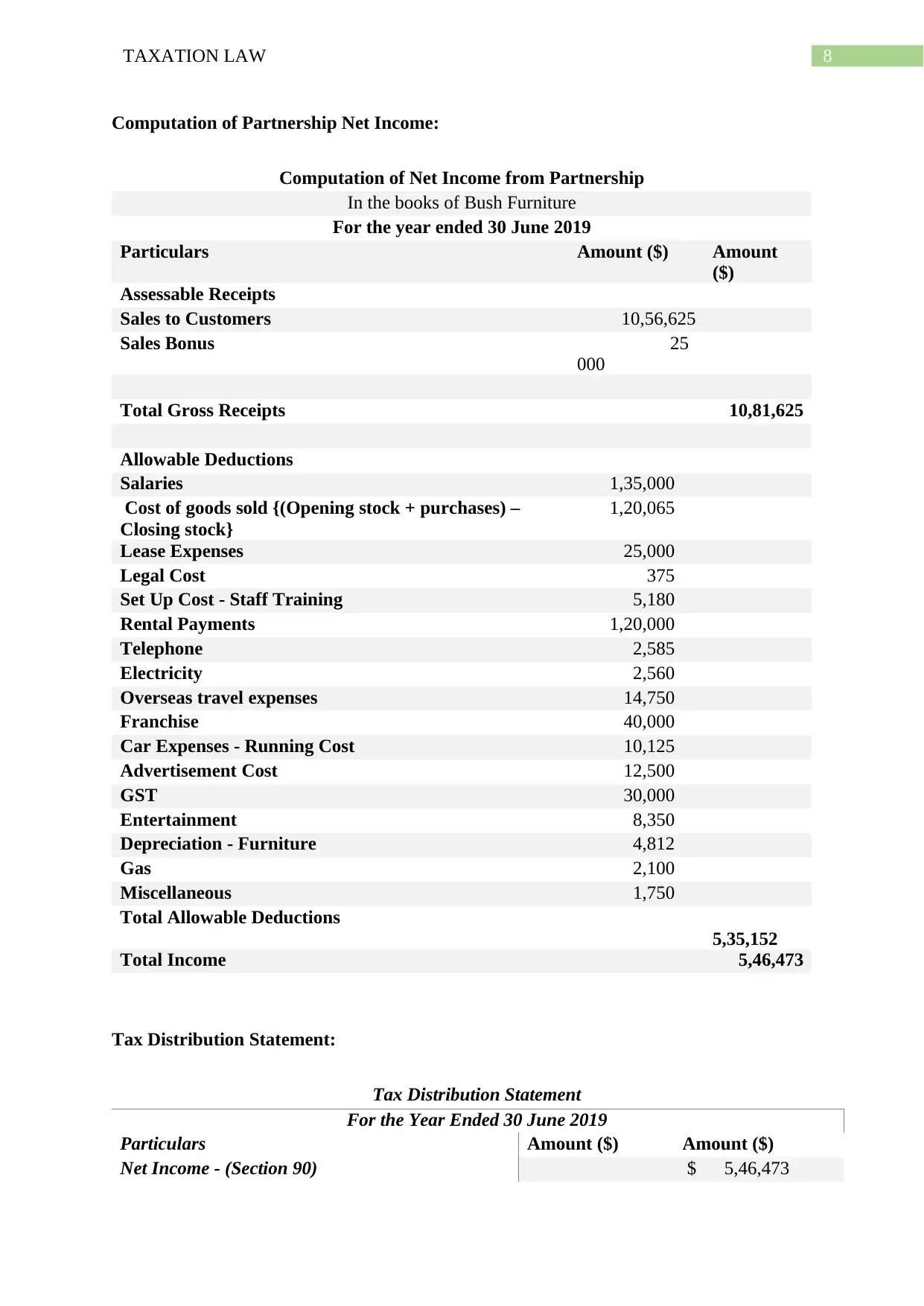
8TAXATION LAW
Computation of Partnership Net Income:
Computation of Net Income from Partnership
In the books of Bush Furniture
For the year ended 30 June 2019
Particulars Amount ($) Amount
($)
Assessable Receipts
Sales to Customers 10,56,625
Sales Bonus 25
000
Total Gross Receipts 10,81,625
Allowable Deductions
Salaries 1,35,000
Cost of goods sold {(Opening stock + purchases) –
Closing stock}
1,20,065
Lease Expenses 25,000
Legal Cost 375
Set Up Cost - Staff Training 5,180
Rental Payments 1,20,000
Telephone 2,585
Electricity 2,560
Overseas travel expenses 14,750
Franchise 40,000
Car Expenses - Running Cost 10,125
Advertisement Cost 12,500
GST 30,000
Entertainment 8,350
Depreciation - Furniture 4,812
Gas 2,100
Miscellaneous 1,750
Total Allowable Deductions
5,35,152
Total Income 5,46,473
Tax Distribution Statement:
Tax Distribution Statement
For the Year Ended 30 June 2019
Particulars Amount ($) Amount ($)
Net Income - (Section 90) $ 5,46,473
Computation of Partnership Net Income:
Computation of Net Income from Partnership
In the books of Bush Furniture
For the year ended 30 June 2019
Particulars Amount ($) Amount
($)
Assessable Receipts
Sales to Customers 10,56,625
Sales Bonus 25
000
Total Gross Receipts 10,81,625
Allowable Deductions
Salaries 1,35,000
Cost of goods sold {(Opening stock + purchases) –
Closing stock}
1,20,065
Lease Expenses 25,000
Legal Cost 375
Set Up Cost - Staff Training 5,180
Rental Payments 1,20,000
Telephone 2,585
Electricity 2,560
Overseas travel expenses 14,750
Franchise 40,000
Car Expenses - Running Cost 10,125
Advertisement Cost 12,500
GST 30,000
Entertainment 8,350
Depreciation - Furniture 4,812
Gas 2,100
Miscellaneous 1,750
Total Allowable Deductions
5,35,152
Total Income 5,46,473
Tax Distribution Statement:
Tax Distribution Statement
For the Year Ended 30 June 2019
Particulars Amount ($) Amount ($)
Net Income - (Section 90) $ 5,46,473
⊘ This is a preview!⊘
Do you want full access?
Subscribe today to unlock all pages.

Trusted by 1+ million students worldwide
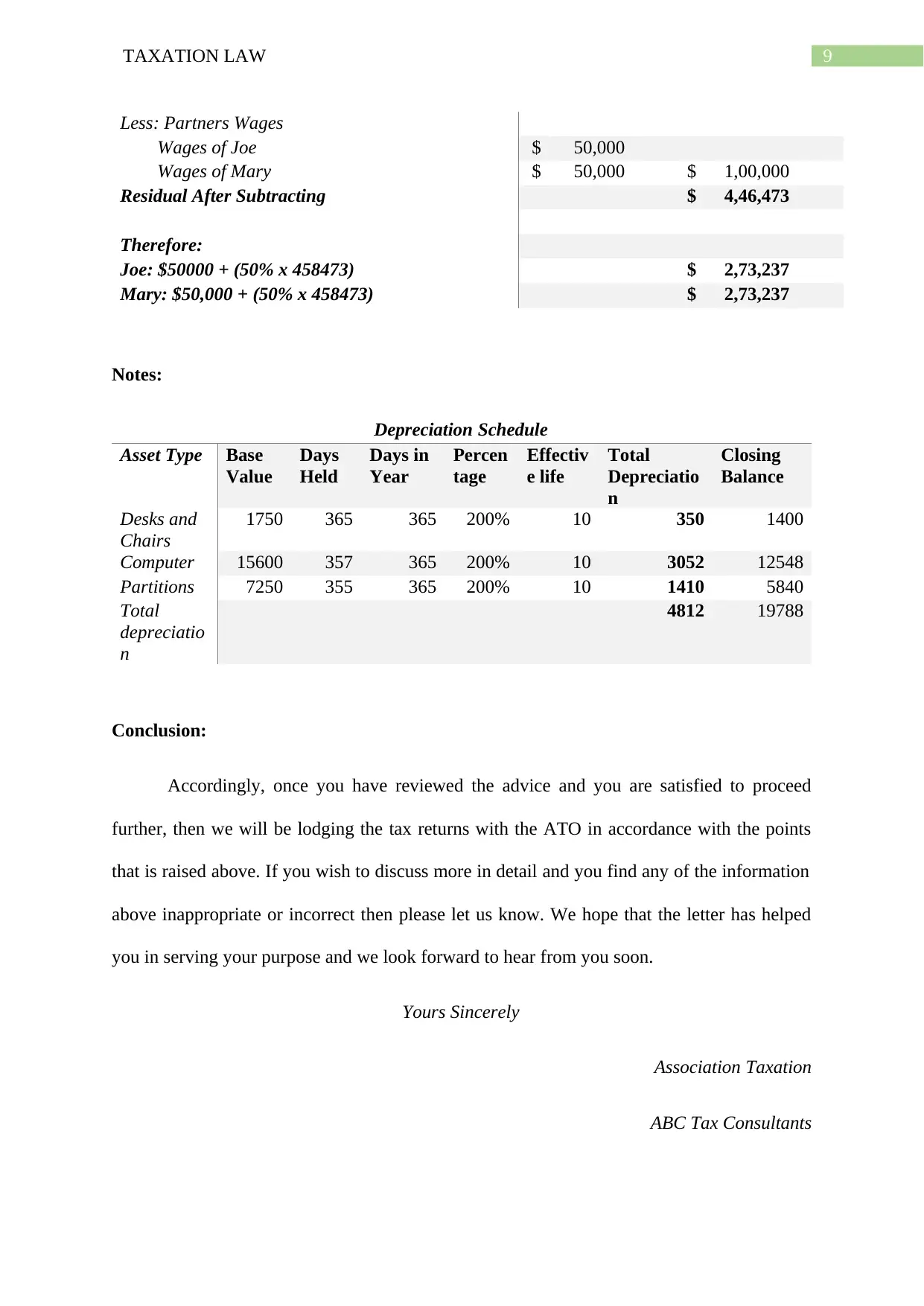
9TAXATION LAW
Less: Partners Wages
Wages of Joe $ 50,000
Wages of Mary $ 50,000 $ 1,00,000
Residual After Subtracting $ 4,46,473
Therefore:
Joe: $50000 + (50% x 458473) $ 2,73,237
Mary: $50,000 + (50% x 458473) $ 2,73,237
Notes:
Depreciation Schedule
Asset Type Base
Value
Days
Held
Days in
Year
Percen
tage
Effectiv
e life
Total
Depreciatio
n
Closing
Balance
Desks and
Chairs
1750 365 365 200% 10 350 1400
Computer 15600 357 365 200% 10 3052 12548
Partitions 7250 355 365 200% 10 1410 5840
Total
depreciatio
n
4812 19788
Conclusion:
Accordingly, once you have reviewed the advice and you are satisfied to proceed
further, then we will be lodging the tax returns with the ATO in accordance with the points
that is raised above. If you wish to discuss more in detail and you find any of the information
above inappropriate or incorrect then please let us know. We hope that the letter has helped
you in serving your purpose and we look forward to hear from you soon.
Yours Sincerely
Association Taxation
ABC Tax Consultants
Less: Partners Wages
Wages of Joe $ 50,000
Wages of Mary $ 50,000 $ 1,00,000
Residual After Subtracting $ 4,46,473
Therefore:
Joe: $50000 + (50% x 458473) $ 2,73,237
Mary: $50,000 + (50% x 458473) $ 2,73,237
Notes:
Depreciation Schedule
Asset Type Base
Value
Days
Held
Days in
Year
Percen
tage
Effectiv
e life
Total
Depreciatio
n
Closing
Balance
Desks and
Chairs
1750 365 365 200% 10 350 1400
Computer 15600 357 365 200% 10 3052 12548
Partitions 7250 355 365 200% 10 1410 5840
Total
depreciatio
n
4812 19788
Conclusion:
Accordingly, once you have reviewed the advice and you are satisfied to proceed
further, then we will be lodging the tax returns with the ATO in accordance with the points
that is raised above. If you wish to discuss more in detail and you find any of the information
above inappropriate or incorrect then please let us know. We hope that the letter has helped
you in serving your purpose and we look forward to hear from you soon.
Yours Sincerely
Association Taxation
ABC Tax Consultants
Paraphrase This Document
Need a fresh take? Get an instant paraphrase of this document with our AI Paraphraser
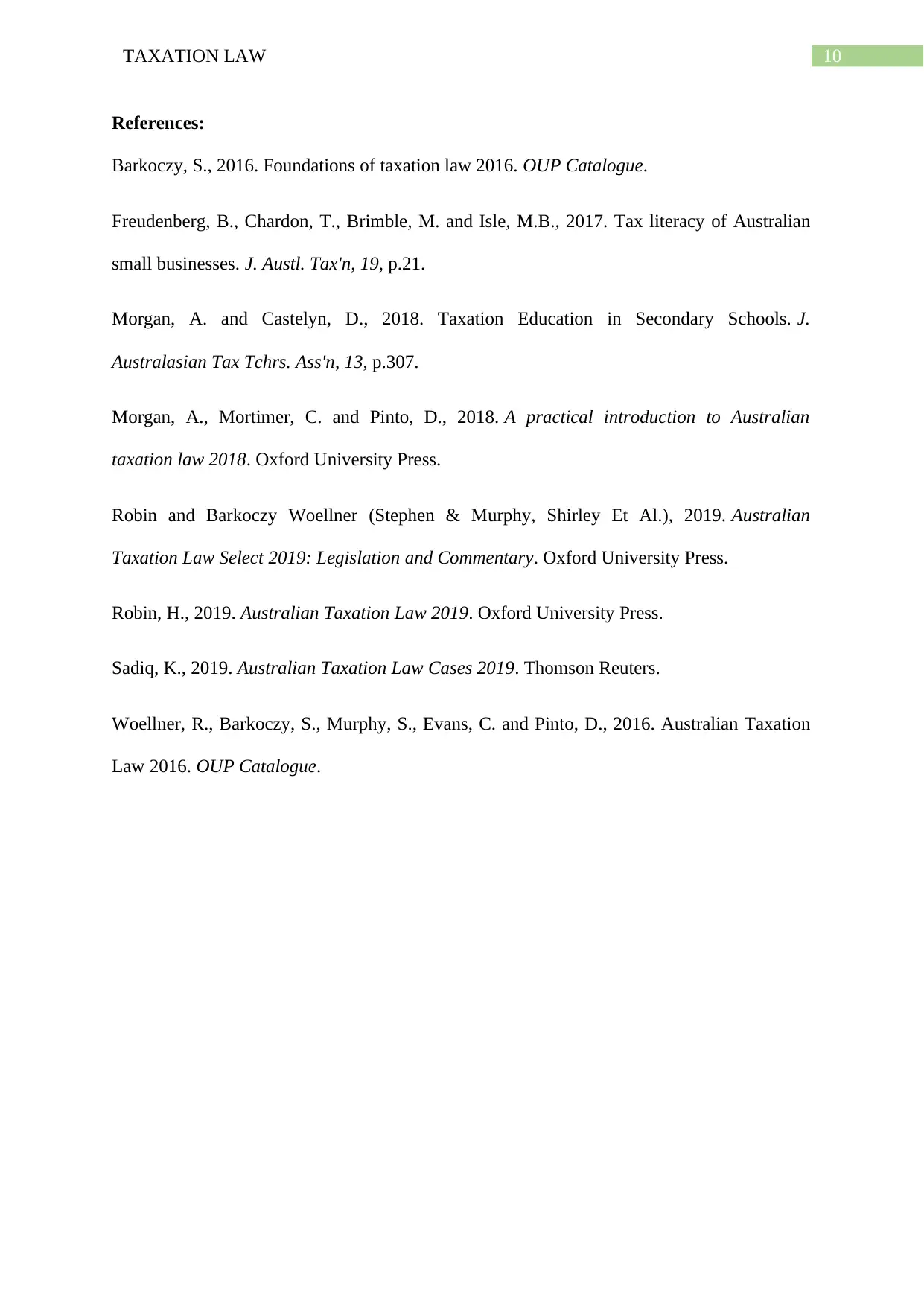
10TAXATION LAW
References:
Barkoczy, S., 2016. Foundations of taxation law 2016. OUP Catalogue.
Freudenberg, B., Chardon, T., Brimble, M. and Isle, M.B., 2017. Tax literacy of Australian
small businesses. J. Austl. Tax'n, 19, p.21.
Morgan, A. and Castelyn, D., 2018. Taxation Education in Secondary Schools. J.
Australasian Tax Tchrs. Ass'n, 13, p.307.
Morgan, A., Mortimer, C. and Pinto, D., 2018. A practical introduction to Australian
taxation law 2018. Oxford University Press.
Robin and Barkoczy Woellner (Stephen & Murphy, Shirley Et Al.), 2019. Australian
Taxation Law Select 2019: Legislation and Commentary. Oxford University Press.
Robin, H., 2019. Australian Taxation Law 2019. Oxford University Press.
Sadiq, K., 2019. Australian Taxation Law Cases 2019. Thomson Reuters.
Woellner, R., Barkoczy, S., Murphy, S., Evans, C. and Pinto, D., 2016. Australian Taxation
Law 2016. OUP Catalogue.
References:
Barkoczy, S., 2016. Foundations of taxation law 2016. OUP Catalogue.
Freudenberg, B., Chardon, T., Brimble, M. and Isle, M.B., 2017. Tax literacy of Australian
small businesses. J. Austl. Tax'n, 19, p.21.
Morgan, A. and Castelyn, D., 2018. Taxation Education in Secondary Schools. J.
Australasian Tax Tchrs. Ass'n, 13, p.307.
Morgan, A., Mortimer, C. and Pinto, D., 2018. A practical introduction to Australian
taxation law 2018. Oxford University Press.
Robin and Barkoczy Woellner (Stephen & Murphy, Shirley Et Al.), 2019. Australian
Taxation Law Select 2019: Legislation and Commentary. Oxford University Press.
Robin, H., 2019. Australian Taxation Law 2019. Oxford University Press.
Sadiq, K., 2019. Australian Taxation Law Cases 2019. Thomson Reuters.
Woellner, R., Barkoczy, S., Murphy, S., Evans, C. and Pinto, D., 2016. Australian Taxation
Law 2016. OUP Catalogue.
1 out of 11
Related Documents
Your All-in-One AI-Powered Toolkit for Academic Success.
+13062052269
info@desklib.com
Available 24*7 on WhatsApp / Email
![[object Object]](/_next/static/media/star-bottom.7253800d.svg)
Unlock your academic potential
Copyright © 2020–2025 A2Z Services. All Rights Reserved. Developed and managed by ZUCOL.





